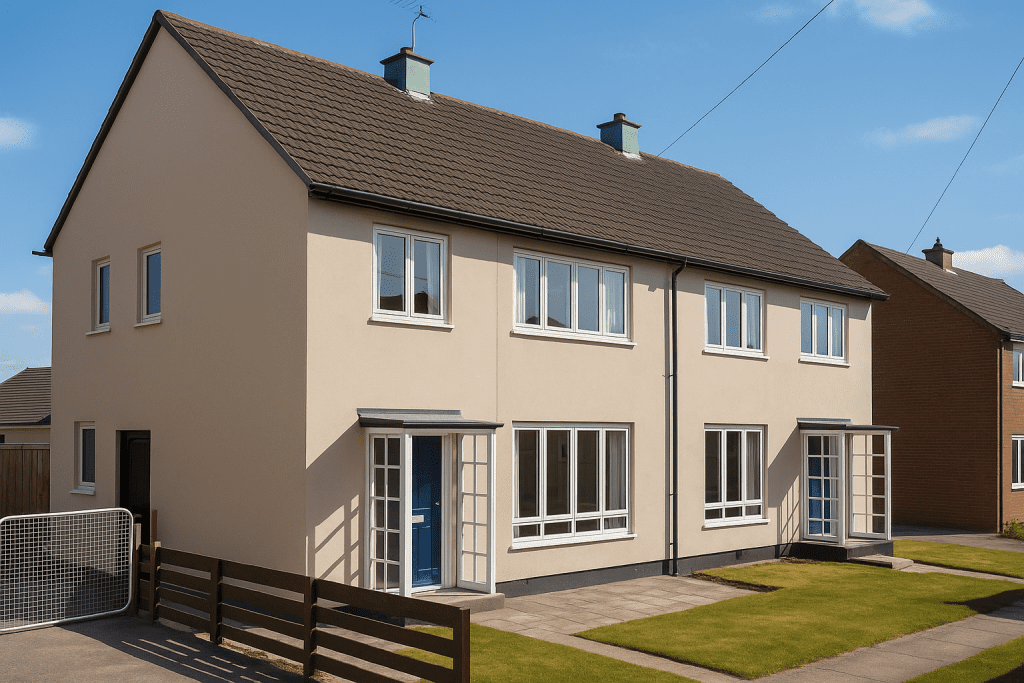Discover how Woolaway construction homes are being transformed into modern, energy-efficient properties across the UK, breathing new life into these unique pre-cast structures.
Understanding Woolaway Construction: A Post-War Housing Legacy
Woolaway construction emerged as a pivotal solution to Britain’s post-war housing crisis in the late 1940s and early 1950s. These innovative prefabricated reinforced concrete (PRC) homes represented a remarkable feat of engineering for their time, enabling rapid construction to meet urgent housing demands. The system, developed by the Woolaway company, utilised factory-produced concrete components that could be quickly assembled on-site, resulting in sturdy, uniform dwellings that helped reshape Britain’s post-war residential landscape. Over 30,000 Woolaway homes were constructed across the UK, predominantly as bungalows and two-storey houses, creating distinctive communities that remain visible in many areas today.
The Structure of a Woolaway Home
Woolaway properties feature a distinctive construction methodology that sets them apart from traditional brick-built homes. At their core, these houses comprise several key structural elements:
- Concrete raft foundations providing a solid base
- Precast concrete columns (typically 6×6 inches) at regular intervals
- Reinforced concrete ring beams connecting the columns
- Aerated concrete wall panels bolted to the frame
- Timber floors and internal partition walls
- Pitched roof structure with traditional tiles
The external walls typically feature a rendered finish, while the internal layout follows conventional domestic arrangements of the period. This unique combination of materials and methods created homes that were initially considered modern and durable, though time has revealed certain limitations.
Challenges Facing Woolaway Homeowners
Modern Woolaway homeowners face several significant challenges that require careful consideration and often substantial investment to address. According to recent surveys, approximately 75% of unmodified Woolaway properties now face some form of structural or practical limitation. The primary issues include:
- Structural degradation of concrete components due to carbonation and reinforcement corrosion
- Poor thermal performance leading to high energy costs
- Difficulty obtaining mortgages due to non-standard construction classification
- Limited resale value without significant modernisation
- Potential issues with building insurance coverage
Modern Solutions for Woolaway Properties
Fortunately, contemporary construction techniques offer various solutions for modernising Woolaway homes. The most comprehensive approach typically involves the PRC (Pre-cast Reinforced Concrete) repair scheme, which has been specifically designed to address the unique challenges of these properties. This process often includes:
- Replacement of concrete panels with traditional cavity wall construction
- Installation of modern insulation systems
- Structural reinforcement of existing concrete frames
- Addition of damp-proof courses and cavity barriers
- Implementation of modern ventilation systems
The Modernisation Process
Modernising a Woolaway home requires careful planning and execution. The typical renovation project takes between 12-16 weeks and involves several crucial stages:
1. Initial structural survey and assessment
2. Planning permission and building regulations approval
3. Appointment of PRC-approved contractors
4. Removal of existing concrete panels
5. Installation of new cavity walls and insulation
6. Modern utilities and services integration
7. External rendering and finishing
8. Final certification and documentation
Financial Considerations
The financial aspects of modernising a Woolaway property require careful consideration. Current estimates suggest a full renovation can cost between £40,000 and £70,000, depending on the property’s size and condition. However, this investment can significantly increase property value and reduce ongoing maintenance costs.
- Government grants and energy efficiency schemes may be available
- Some local authorities offer specific funding for PRC home improvements
- Specialist mortgage products exist for renovation projects
- Post-modernisation insurance premiums typically reduce
- Energy bill savings can offset renovation costs over time
Future-Proofing Your Woolaway Home
Modern renovation techniques offer opportunities to transform Woolaway properties into energy-efficient, comfortable homes that meet contemporary standards. Key improvements often include:
• Installation of smart home technology for improved energy management
• Integration of renewable energy systems like solar panels
• Implementation of modern heating and cooling solutions
• Addition of high-performance windows and doors
• Enhanced insulation systems exceeding current building regulations
Making the Decision: Renovate or Relocate?
The decision to modernise a Woolaway home should be based on careful evaluation of several factors. Recent market data shows that fully modernised Woolaway properties can achieve up to 90% of the value of traditional construction homes in the same area. Consider:
- Current property value and potential post-renovation value
- Local property market conditions and trends
- Cost comparison between renovation and relocation
- Personal attachment to the property and location
- Long-term investment potential
Consulting with property professionals, structural engineers, and specialist contractors can help inform this important decision. With proper planning and execution, Woolaway homes can be successfully transformed into modern, efficient properties that meet current building standards while maintaining their unique character.
FAQ
What are the negatives of bungalows?
The Drawbacks of Bungalows Bungalows often come with a higher price tag per square foot than houses. Since they require larger plots to accommodate their single-storey layout land costs increase particularly in high-demand areas like the South East or Greater London.
Why are bungalows moldy?
In our experience the overwhelming majority of damp problems in bungalows are a result of condensation – which is caused by your home being too air-tight. You might have a problem because of a leak – but this is likely to be very obvious and limited to a small area.
Where is the biggest heat loss in a house?
Windows and doors: As most of this surface is taken up by the walls and the roof, it is here that most of the heat is lost. Gaps around window and door frames allow cold air to get in and warm air to escape, and even your letterbox can allow significant heat to escape.
Do bungalows lose more heat than houses?
Heating and Insulation Potential for Heat Loss: Some bungalows, particularly older ones, may have less effective insulation, leading to higher heating costs. Energy Efficiency Concerns: Ensuring energy efficiency can be more challenging in single-storey homes with larger footprints.
Do bungalows go up in value?
Yet according to recent reports, the once humble bungalow is now “seriously cool” and in high demand – the average price of a bungalow rose by 17% in the year to May 2023, compared with 13% for houses and 5% for flats.
Sources
[1] https://flettons.com/the-woolaway-house-a-comprehensive-guide-for-home-buyers-and-investors/
[2] https://alsyedconstruction.com/what-is-woolaway-construction/
[3] https://www.structherm.co.uk/non-traditional-profile-woolaway-refurbishment/


Leave a Reply